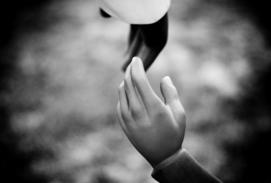Connecting with children in the wake of tragedy and political violence
Author: Kelly Matteri
Published: 11.18.15

Editor's note: This blog post was originally written in 2015 but, because of its timeliness, we decided to feature it again.
I know I am not alone when I say I have found it difficult to wrap my head and heart around the tragedies of recent days. Sadness, anger, fear and confusion weigh heavy on adults in the wake of the attacks in Beirut and Paris. For children with an awareness of the events, those same feelings may be just as great, but harder to comprehend.
Over the last few days, parents and teachers across the globe have asked the following question of themselves and others:
“How do we talk to children about the attacks?”
There are many sound sources that offer a response to this question, including CNN’s article, How to Talk to Kids About Tragic Events, and National Child Traumatic Stress Network’s fact sheet, Talking to Children about the Shooting.
However, I found Jill Eisenberg’s post Talking to Kids about Current Events and Conflicts to be particularly insightful and applicable for classroom teachers. Eisenberg is the writer of Lee and Low Books’ blog, the open book, and brings a unique and valuable perspective to the discussion.
Eisenberg reframes the question:
“How do we talk to children about these events and use these moments as opportunities to have respectful, honest (albeit age-appropriate) discussions?”
Short, but powerful, open-ended questions that can help guide a conversation between teacher and students, or parents and children are listed.
- What questions do you have? What have you heard?
- What do you know about the situation or group of people/foreign country involved?
- Who are the countries or communities involved?
- How are different communities and countries coming together over this issue?
- What would you like to do to help?
Eisenberg suggests picture books as a powerful resource for exploring difficult topics in a way that is accessible for children.The post links to children’s books that exemplify themes like human dignity, the strength, courage, and resilience of children, and a community’s capacity to endure, love, and give.
Eisenberg writes, “Children’s books dealing with conflict or natural disasters can frame the event in contexts and meanings suitable to their developmental stage. Stories with children as the main characters allow children to identify with the characters over universal themes.”
As adults, and particularly as teachers or parents, we may believe that our job is to help the children in our lives make sense of the world around them. We may believe that in order to help children make sense of something, we need to have made sense of it ourselves first. In situations like those that hold our attention now, we do not have that luxury.
Maybe right now the best we can do for the children in our lives is to pick up a book and open up a conversation. Maybe the only way to make whatever sense can be made out of tragedies like these, is to make sense of it together.
A more compassionate world is possible. Those of us who work with children are uniquely positioned to help achieve that world. I’ll see you out there in classrooms and community circles, fellow readers. I’ll be the one with hope in my heart and a book in my hand.
Blog: English Language Arts

